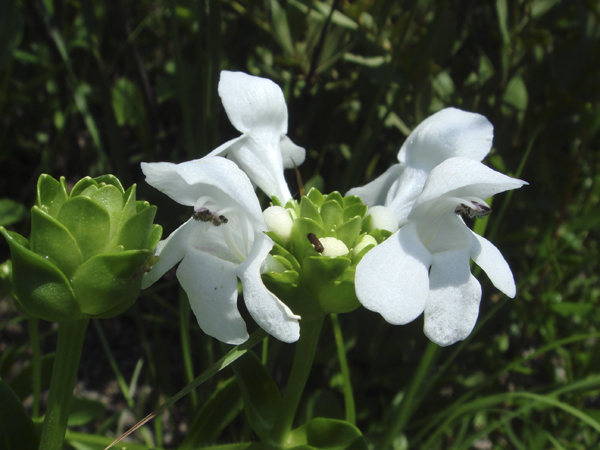Letting the Light In for Rare Plants!
Submitted by Michael R. Jenkins, Magnolia Chapter. Plant Conservation Program Biologist, Florida Forest Service, Florida Department of Agriculture and Consumer Services
Sometimes sun-loving (usually pyrophytic) plant populations are in heavy competition with taller, woody plants and in need of help from an outsider. Here, someone with a pair of loppers, work clothes, water, and a few hours can really help. How about an 80% increase-in-stems kinda help? This situation was encountered where a nice population of White Birds-In-A-Nest (Macbridea alba) highly benefited from hand removing competing small trees and shrubs from around the plants, done to open up the habitat and to mimic fire (somewhat). This was done by one person working for just four hours. This person is the "fuel buster."
Sometimes sun-loving (usually pyrophytic) plant populations are in heavy competition with taller, woody plants and in need of help from an outsider. Here, someone with a pair of loppers, work clothes, water, and a few hours can really help. How about an 80% increase-in-stems kinda help? This situation was encountered where a nice population of White Birds-In-A-Nest (Macbridea alba) highly benefited from hand removing competing small trees and shrubs from around the plants, done to open up the habitat and to mimic fire (somewhat). This was done by one person working for just four hours. This person is the "fuel buster."
This particular “White Birds” population covers about a quarter of an acre in a habitat classified by Florida Natural Areas Inventory (FNAI) 2010 Natural Community Guide as a Wet Prairie but within a matrix of Wet and Mesic Flatwoods, and Bottomland Forest. Interestingly and untypically, White Birds here grow up to the edge of a small stream. The population has been periodically monitored since it was first found by botanist Wilson Baker in 2003 and documented in the FNAI Florida Element Occurrence database of rare plants, animals, and natural communities.
 |
| White-Birds-In-A-Nest bloom in late June and July. Photo: Michael R. Jenkins |
The population was
surveyed for the year and flags were placed around all points that had ever
been taken there since 2003. To remove the heavy fuels, the site was revisited
in March, when superterranean portions of the White Birds were not visible. All
heavy fuels were cut and cleared out over the flagged population with a pair of
loppers, cutting them to ground-level and removing the cut plants away from the
population to increase sunlight. The cuttings were placed in areas outside of
the Wet Prairie in thicker areas of the Bottomland Forest and on top of large
briar patches.
 |
| Picture of east portion of White Birds-In-A-Nest population (large, white flowers) where heavy fuels were removed and plant reacted very positively. Photo: Michael R. Jenkins |
They had formed quite a groundcover in some places! Flowering increased also with the increase in stems but what was really eye-popping was the stem-density and vigor of the plants in the area where the heavy fuels were removed. The plants also came up into new areas that were not cut but adjacent to the cut site, enlarging the population. They obviously had a very positive response to this management technique that is easy and fun to do. The same effort will be done each year.
This was the best
response we have had by a species to this “fuel busting” technique, similar to
ones done in the Panhandle by past Florida Park Service biologist, Tova Spector
in pitcherplant bogs that increased pitcherplant and terrestrial orchid
populations. These are now being continued by Atlanta Botanical Garden and
several other organizations and individuals throughout Florida. We have had
increased flowering in all fuel buster areas for Pot-of-Gold Lily, Florida
Beargrass, Lewton’s Polygala, Godfrey’s Butterwort, and other pitcherplant and
butterwort species. It is important to note that you must be committed to
follow up treatments of a site for successive years because of the heavy
resprouting from the cut woody plants that occurs soon after cutting.
I agree! Where rare native plants are in similar harms way, we need more "Fuel Buster" patrols.




Comments